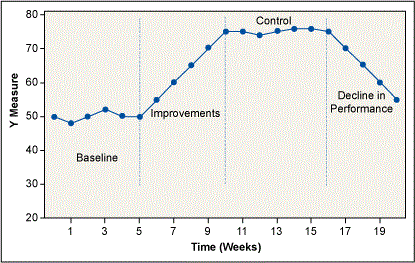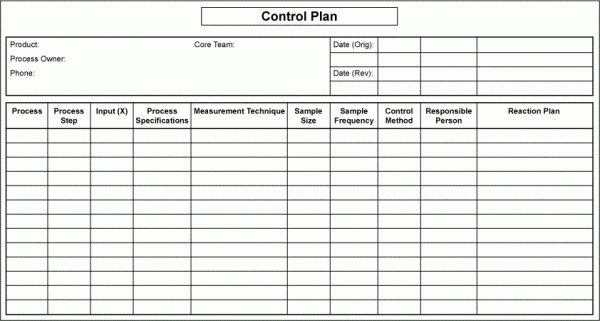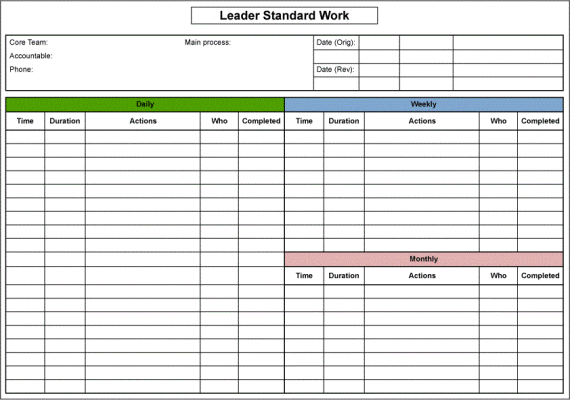
Lean Six Sigma (LSS) can have a major positive impact on organizations that apply it; however, not every company has achieved the desired results. One of the reasons for that lack of success is the inability to sustain improvements yielded from LSS projects. Through LSS projects the aim is to make improvements to address a business problem – such as increasing output, reducing cycle time or reducing defects. Using the DMAIC (Define, Measure, Analyse, Improve, Control) methodology, improvements are implemented to address the problem. However, without appropriate control measures, over time improvements are likely to drift back to baseline. This can be for a multitude of reasons including a switch in focus of the organization, lack of buy-in of the process owner, quality of solutions implemented, lack of accountability, an eagerness for the Black Belt to work on other projects, or actions within the Control phase rushed in order to close the project (if even completed).
Figure 1 displays an output measure before, during and after improvement implementation. There is a gradual improvement in production output during implementation (weeks 5 to 10), output is sustained for six weeks post-improvement, and then a reduction in output occurs.

This can become a major problem across organizations. Without putting appropriate balance-and-check steps in place, organizations will run the same projects over and over again.
To address this problem, use the steps in Control!
The first steps of sustaining improvements should be considered before reaching the Control phase – within solution development and prioritization stages. Developing solutions that have self-control mechanisms removes the opportunity for the output measure to revert back to baseline. How can a LSS team achieve this?
Mistake Proofing
A key tool available to the project team is mistake proofing, or poka-yoke. Applying techniques of mistake proofing can eliminate the opportunity for the change to regress. Developing a solution where a defect is impossible is the ultimate form of control. The mistake proofing power scale example (shown in the table below) enables the project team to understand how effective their solutions will be.
| Example of Mistake Proofing Power Scale | |||
| Power Scale | Method | Description | Example |
| 10 (High) | Eliminate | Redesign product or process so task/part is no longer required to eliminate defect opportunity | Automatic handbrake – simplifies process and removes step where error occurs |
| 9 | Control | Prevent errors from becoming defects – provide immediate feedback and self-correction | USB stick – only able to connect to computer in one, correct position |
| 8 | Shutdown | Prevent errors by forcing a shutdown when error is detected | Website page – will not advance to next screen due to missing form data |
| 7 | Replace | Replace current process with a more reliable process | Scanner – replaces manual data entry |
| 6 | Mitigate | Minimize effects of errors or provide quick/easy method of correction | Fuses in a plug – prevents overloading of a circuit |
| 5 | Warn | Automatically alerts operators of abnormal conditions (requires operator intervention) | Car fuel warning gauge, smoke alarm |
| 4 | Sensory warning | Once error is detected, operator initiates signal that uses one or more of the five senses | Fire alarm – operator activates when fire is detected |
| 3 | Facilitate | Use visual aids to make it easy to do something without error | Visual controls, checklists, self-assembly instructions |
| 2 | Build standards | Make work environment communicate established standards | Visual displays, color coding – conditional formatting, labels |
| 1 | Share standards | Establish best method for correctly doing something and share with all required individuals | Training, quality procedures |
| 0 (Low) | Share information | Identify key information required for successful process and communicate to all individuals | Share information in person or by email |
During solution development and prioritization, the team is able to rate solutions against the power scale and challenge them accordingly. There are many different methods to generate solutions; however, if the team can develop solutions reaching Levels 9 and 10 on the power scale – control and eliminate, respectively, the potential for mistakes is removed. For example, the team may remove a process step where the defect occurs or remove an opportunity to make an error – such as adding speed restrictors to vehicles. Common solution ideas such as training operators are low on the power scale and, therefore, will have limited effect with regards to sustainability. If all of the solutions generated are low on the power scale, the project team should look to generate other solutions that are more effective.
The goal for the project team when developing solutions has to be to identify solutions that will eliminate the risk of a mistake; use of the mistake proofing power scale within solution development enables the team to drive toward this goal. This can be critical with regard to safety incidents – eliminating the opportunity of making a mistake can protect employees from harm.
Control Plans
What should the project team do if they are unable to eliminate the opportunity of a defect or they cannot put a self-control mechanism in place?
To maintain improvements in an output measure, one method for success is to implement a control plan, a template for which is shown in Figure 2.

What should be included within a control plan?
The critical Xs (inputs) should be included in the control plan; monitoring these and addressing any issues will result in maintaining improvements in the output measure. Far too often, project teams try to track too many measures, which is not sustainable. It is key to track and monitor the critical inputs (identified within the Analyze phase), detail the specification limit of each input, how the input will be measured and an appropriate sampling plan for the process, identify who is responsible for tracking the measure, and agree to a reaction plan if the input falls out of specifications.
Who should develop the control plan?
The project lead develops the control plan with the team, including the project champion and process owner. Within the control phase it is critical that ownership of the process is handed back to the process owner – their involvement in the control plan development is mandatory. Ownership and accountability are fundamental to ensure the critical Xs are monitored and appropriate actions are put in place to react when the inputs are out of control. Failing to include key stakeholders in the development of the control plan will only see it fail and, subsequently, the output measure will revert back to baseline.
How do you track critical Xs?
Tracking critical inputs is key to applying control measures and maintaining improved performance. In some cases, inputs may already be tracked. If this is not the case, however, developing a simple measurement system is essential. Developing an automated system to track critical inputs is the optimum method. Failing this, however, a simple standardized method to extract and collate the data is required (for example, Microsoft Excel/Access templates). Any action that takes greater than five minutes to complete on a daily basis could lead to an I-did-not-have-time-today attitude. Applying the simplify–standardize–automate approach to tracking inputs is key from a sustainability perspective.
Using control plans successfully requires ownership and, ultimately, accountability for maintaining the process improvements. Within certain industries, control plans are mandatory for every process – they are a standard way of working and not just a result of an improvement project. Control plans are requirements to remain competitive in the market and maintain improvements. Making control plans the standard in an organization will address issues with sustaining improvements.
Leader Standard Work
If control plans are not standard at an organization, how can the same process be applied the same way day after day?
Leader standard work is a daily checklist for each leader. It is a basic concept, but is key to driving accountability across a department and an organization. Figure 3 provides a template for leader standard work that can be personalized. Leader standard work is a document that is designed to be carried around and used to remind each leader of their daily, weekly and monthly responsibilities.

What should be included in the template?
From the control plan, either monitoring critical inputs or checking that the responsible person is completing this task are key responsibilities of the leader. This activity should be detailed on the leader standard work template accordingly.
In addition to the checklist, the document can be used to capture notes, observations or appropriate actions which link to the reaction plans within the control plan.
How do you integrate leader standard work into your organization?
Senior management buy-in is critical. A top-down leadership approach is required, with each leader submitting daily/weekly tasks to their direct managers. In essence, leaders are providing updates on their activity along with a mechanism to track their compliance. Without the engagement and accountability of senior management, performance will start to drop. Combining leader standard work with other Lean toolsets (such as visual controls and tiered accountability meetings) is an effective way to maintain compliance; issues can be seen and addressed accordingly. Applying specific Lean tools, such as leader standard work, is a structured method to maximize effectiveness of control plans and, in turn, sustain improvements.
Conclusions
Within many organizations, maintaining improvements is a significant challenge. Spending time to implement appropriate control measures in a project helps to address this (along with change management strategies).
The steps to sustaining improvements are:
- In the Improve phase, look at mistake-proofing options. Eliminating opportunities for defects is the greatest form of control – question sustainability of solutions low on the power scale.
- Develop a control plan with the project team, including the project Champion and process owner. Hand over the control plan to the process owner and ensure there is clear accountability assigned with the project Champion.
- Automate measurement systems of critical inputs where possible, or at least simplify and standardize the method to source data on critical inputs.
- Incorporate control plan checks into leader standard work – drive accountability for actions and maintain improvements.
Do not fall into the trap of believing the hard work has been done when the improvements have been implemented – the journey has only just begun. Take time with the project team to implement control measures and the team’s efforts will be seen and felt for a long time to come.